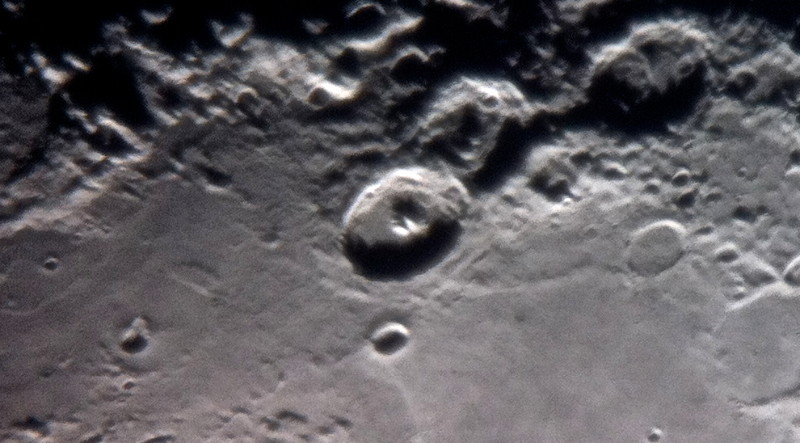
Nine Hour Session: Imaging Venus, Moon, & Many Galaxies
Posted: 27 April 2012
Opened the observatory Thursday, 26 April, at 1800 MST, 79°F. This was to be a long session, with several galaxies planned for imaging. After arriving at the observatory, I delayed opening the dome due to strong breezes that were blowing. I installed newly received improved bolts and clamps on the Magnilux MX-1 iPhone Afocal Adapter. Click the link to read my updated review. At 1826 MST, I opened the dome. It was still rather breezy, so I added two extra clips to my POD Roller Desk to keep the pages of my logbook from flipping in the wind. Powered up the 8" LX200-ACF at 1830 MST and viewed Venus at 77X and 364X. Lovely crescent. Took this iPhone 4 afocal image, 666X, cropped, with the MX-1 adapter:

Then viewed the moon at 77X and 206X. The central peaks in the Crater Theophilus were very distinct, even 10 minutes before sunset. Captured this moon image, iPhone afocal, 77X, about 10 minutes after sunset:

This is the Crater Theophilus, iPhone afocal, 231X, cropped:

At 1928 MST, I began a tour of the lunar terminator at 364X. The central peaks in the Crater Theophilus were really fascinating. At 1937 MST, viewed Mars, 206X; North Polar Cap and a very bright sunrise cloud were visible. Due to poor seeing, no dark areas were visible. At 1943 MST, took a quick look at Saturn, low in the southeast, 77X.
Next, I began setting up for a Drift Alignment of the mount. I had not done one in a long time, so figured it was time. Switched from the star diagonal to a visual back. Used a Meade Illuminated Reticle Eyepiece to monitor the drift. I made some adjustments in both azimuth and latitude. Completed the Drift Alignment at 2113 MST and did a One Star AutoStar alignment.
At 2125 MST, viewed Saturn at 77X, 133X, 206X, and 364X. Seeing was not good enough for 364X. Four moons were visible: Titan, Dione, Rhea, and Tethys. After some study, I picked up Enceladus at 77X.
At 2140 MST, I began preparations for the night's DSO imaging at prime focus using the D7000 DSLR and Off-Axis Guider. I had to wait until 2330 MST to begin guided DSO imaging due to the crescent moon. Once the moon was nearly gone from the sky, I began taking 5 minute, ISO 6400, exposures. For most images, I found a guide star. However, on some objects I could not locate a good guide star and will try again on the next session. These are the images I captured, all slightly cropped from the full-frame image:
M88:

M91:

Coma Galaxy Cluster:

NGC4261:

M61:

M49:

M89:

M90:

M59:

NGC4697:

I ended imaging at 0225 MST. Viewed M20 (Trifid Nebula), M17 (Swan Nebula), M22 (globular cluster), and M16 (Eagle Nebula) at 77X.
Closed the observatory at 0300 MST, 52°F. A wonderful nine hour session in the observatory.
On my "wish list" is a wide angle lens for my D7000 DSLR to do all-sky astrophotography. Wow, could I take some nice shots with this 6mm f/2.8 lens!
Comments are welcome; use the Comments section below, or you can Email Me. Thanks.
Go to the previous report.
Return to the Cassiopeia Observatory Welcome Page.